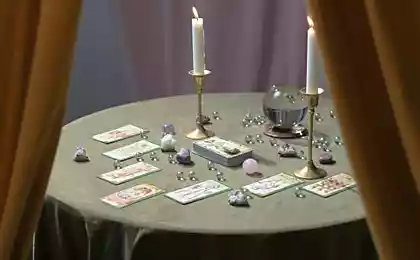568
Bonfires are against feminism—that burned witches
One of the biggest mysteries in history is still strange insanity that swept Europe in the XV-XVII centuries, in which the fires travelled thousands of women suspected of witchcraft. What was it? Malice or cunning calculation?
In respect of the suppression of witches in medieval Europe there are many theories. One of the most original is that no distraction was not. People really struggled with the dark forces, including witches proliferated all over the world. If desired, the theory can be developed.
Hardly the witchcraft ceased to fight, how in the world here and there began to break out of revolution and the increasing scope began to take on terrorism. And these events played a significant role in women seemingly turns into the evil furies. And in fomenting the current "color" revolutions, they also play a prominent role.
Pagan tolerance of Pagan religion in General was tolerant of sorcerers and witches. It was simple: if sorcery was for the good of the people, it was welcomed, if harm is punished. In Ancient Rome elected by the punishment of sorcerers, depending on the harmfulness of what they have done. For example, if you caused the harm by witchcraft could not pay the victim compensation, he had to be the injury. In some countries, witchcraft was punishable by death.
That all changed with the advent of Christianity. Drink, walk on the side and cheat the middle was considered a sin. And the sins are declared, by the devil. In the Middle ages a vision of the world, ordinary people began to form the educated people of that era — the clergy. And they imposed their worldview: that all the troubles on earth are descended from the devil and his henchmen, the demons and witches.
The witches blamed all natural disasters and failures in business. And it seems that the idea — the more witches to destroy, the more happiness will halt all remaining people. First witches burned singly, then in pairs, then tens and hundreds.
One of the first known cases was the execution of witches in 1128 in Flanders. A woman threw water on one of the nobleman, and he soon collapsed from pain in the heart and the kidneys and after some time died. In France, the first known burning of a witch took place in Toulouse in 1285, when a woman was accused of cohabitation with the devil, why she allegedly gave birth to a cross between a wolf, a snake and a human. And after some time the execution of witches in France became popular. In the years 1320-1350 the stake in Carcassonne went up 200 women in Toulouse — more than 400. And soon the fashion for the massacre of witches spread throughout Europe.
The world has gone mad In Italy, after being published in 1523 the bull about witches of Pope Hadrian VI, only in the Como lake area every year to burn over 100 witches. But most of all, witch was in Germany. The German historian Johannes Scherr wrote: "Executions by time over all masses begin in Germany around 1580 and continued for almost a century. While all Lorraine smoldering from the fires... in Padeborn, Bredenbury in Leipzig and its surroundings were made, too many executions.
In the County of Wagenfeld in Bavaria in 1582 single process has led to the stake 48 witch In Brunswick between 1590-1600 years burned as witches (daily 10-12 people) that the infamous posts was a "dense forest" in front of the gate. In a small County in one Henneberg 1612 22 burned witches, 1597-1876 the years 197... Mindgame, numbering 540 residents with at 1661 1664 year burned 30 people.
There was even its record for executions. Fulda judge Baltasar Voss boasted that he alone burned down 700 sorcerers of both sexes, and hopes to bring the number of its victims to one thousand. Special passion in the persecution of witches distinguished by the würzburg Bishop Philipp Adolf von Ehrenberg. In würzburg, he organized 42 fire, which burned 209 people, including 25 children aged four to fourteen years. Among those executed was the most beautiful girl, the fat woman and the fat man, a blind girl and student, who spoke many languages. Any difference between man and other seemed to the Bishop direct evidence of connections with the devil.
And even more committed atrocities his cousin, the Prince-Bishop Gottfried Johann Georg Fuchs of the Second background Dornheim, executed in Bamberg in the period 1623-1633 years, more than 600 people. The last mass burning in Germany was arranged by the Archbishop of Salzburg in 1678, when the fire went from 97 people.
Alas, did not stay aside from the witch hunt, and Russia. So, when in the year 1411 in Pskov started the plague, accused-inflicted disease is burned from 12 women. However, in comparison with Western Europe, we can say that in Russia the witches tolerated. And usually severely punished only if they are evil to the Emperor. In General, burned rarely, more flogged.
In Europe, however, not only burned, but also tried to execute with great sophistication. Judges sometimes insisted that the execution of a witch had her young children. And sometimes with the witch were sent to the bonfire and her family. In 1688 the whole family, including children and servants, were burned for witchcraft.
In 1746, burned not only the accused, but her sister, mother and grandmother. And finally, the execution at the stake was intentionally done to further humiliate the woman. First burned her clothes, and she for some time remained naked in full view of the crowds gathered to see her mortification. In Russia, however, is usually burned in the wooden house, perhaps to avoid this very shame.
Not only the Inquisition Accepted that a witch hunt staged by the Inquisition. It is hard to deny, but it should be noted that not only she. For example, in Würzburg and Bamberg bishoprics rampage is not the Inquisition, and the Episcopal courts. In the town of Lindheim in the Grand Duchy of Hesse tried witches ordinary people. Headed the Tribunal soldiers of Gass, a veteran of the Thirty years war. The jury consisted of three farmer and weaver. Residents of Lindheim nickname for these people from the people "jury-bloodsuckers" because they sent people to the stake at the slightest provocation.
But perhaps the most evil were the Protestant leaders of the reformation, Calvin and Luther, which we had previously provided bright heroes who defied the dark Catholics. Calvin introduced a new way of burning of heretics and witches. To make the penalty more extended and painful, the condemned were burned at the raw wood. Martin Luther hated witches with all his heart and summoned to execute them personally.
In 1522, he wrote: "Wizards and witches — the essence of evil spawn of the devil, they steal the milk, bring bad weather, curse people with a spell, the strength in his legs taken away, tortured children in the cradle, compels people to love and copulation, and innumerable machinations of the devil." And under the influence of his preaching, Protestants in Germany were sending women to the stake on the slightest suspicion.
I must say that the Inquisition, although it led the bulk of the witch processes in its work, strictly followed the procedural rules* for Example, required that a witch confessed. However, the inquisitors came up with a bunch of different devices of torture. For example, the "witch's chair", equipped with sharp wooden spikes on which the suspect was forced to sit for days.
Some witches wore on his feet leather boots big size and filled them in boiling water. Feet in such shoes are literally welded together. And Brigitte von Ebikon in 1652 tortured boiled eggs that were removed from the boiling water and put her under the arms.
In addition to recognition, other evidence of the connection of women with the devil could be the test of water. It is curious that Christians adopted it from the pagans. Even the laws of Hammurabi in the second Millennium BC, it is recommended that those accused of witchcraft to go to the deity of the River and into the River to plunge; if the River got him, his accuser will be able to take him home. If the River will cleanse this man, he may take the house of the Prosecutor.
Still more substantial proof of guilt of a witch than her confession, was on her body the "marks of the devil." Distinguish two varieties — "witch's mark" and "mark of the devil". "Witch sign" was supposed to resemble a third nipple on a woman's body, it was believed that through him she fed the demons in his own blood.
And the "mark of the devil" called unusual growth on the skin, insensitive to pain. Now there's a theory that the "witch's mark" and "mark of the devil" characteristic for only one disease. It is leprosy, or leprosy.
With the development of leprosy the skin begins to harden and forms sores and knots that can really resemble the nipple and insensitive to pain. And when you consider that the apogee of the spread of leprosy in Europe peaked in the Middle ages, it turns out that the inquisitors under the guise of a witch hunt struggled with an epidemic of leprosy.
Fires against feminism , There is one interesting theory. If the Inquisition is a tool of male monastic orders — the witch-hunt trying to put women in place. The Crusades and strife thoroughly decimated the ranks of men in Europe, and because, especially in rural communities, the female majority to dictate their will to the male minority.
And when the men tried to intimidate the women by force, they threatened to send them all kinds of misfortune. The dominance of women was a danger to ecclesiastical foundations, because it was believed that the daughters of eve, the hero of the fall, could do us great harm, give them the will and power.
Not by chance, using accusations of witchcraft often dealt with women, attained great influence and high standing. In this regard, we can recall the execution of Henry VIII's wives — Anne Boleyn. One of the charges brought against her in 1536 charges became witchcraft. And evidence of the connection with the evil spirit became a sixth finger on one hand Anna.
And the most famous execution of witches in centuries remained the burning of Joan of Arc 30 may 1431 in the city of Ru-Ana. The Inquisition initiated a process of accusation of the maid of Orleans witchcraft, disobedience of the Church and wearing men's clothing. During her execution in the middle of the scaffold stood a pole with a Board where was written: "Joan, who calls herself a Virgin, peroushtitsa, witch, wretch a blasphemer, a bloodsucker, a servant of Satan, raskolnitsa and a heretic".
In the Guinness Book of records said that the last conviction for witchcraft were executed maid Anna, Galdi in the Swiss town of Glarus in June 1782. The proceedings against her lasted 17 weeks and 4 days. And for most of that time she spent in chains and shackles. However, Geldi saved from burning to death. She was beheaded.
And the last witch in the history of mankind was burned in the Mexican city of Camargo in 1860. Experts estimate that in the period of the witch hunts of the sixteenth and seventeenth centuries were executed, at least 200 thousand women.
Oleg LOGINOV
source: nlo-mir.ru
Source: /users/1























